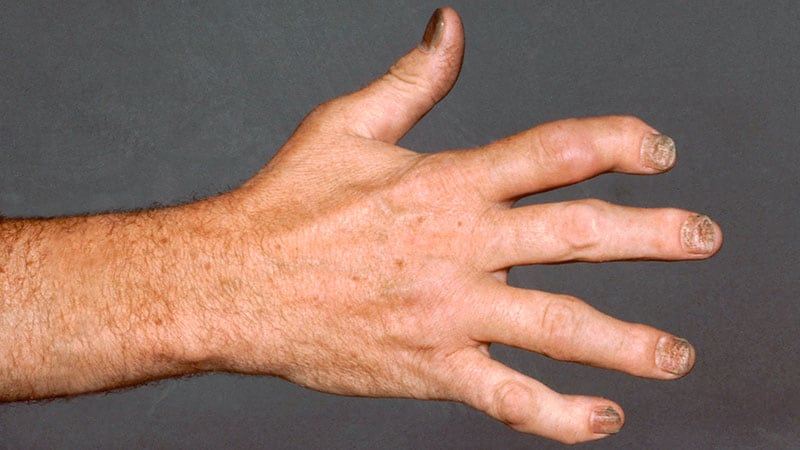TOPLINE:
Compared with patients with psoriatic arthritis (PsA) receiving placebo, those receiving secukinumab demonstrated a significant reduction in bone erosion volume and improvement in partial healing of erosions after 1 year, as assessed by high-resolution peripheral quantitative CT (HR-pQCT).
METHODOLOGY:
- Researchers conducted a randomized controlled trial to compare the effects of secukinumab (an anti–interleukin 17A monoclonal antibody) and placebo on the progression of bone erosions and enthesophytes in patients with PsA recruited from four hospitals in Hong Kong (May 2020–August 2021).
- They included 40 adult patients with active disease (mean age, 51.9 years; 50% women; mean disease duration, 4.7 years) despite previous treatment with nonsteroidal anti-inflammatory drugs or conventional synthetic disease-modifying antirheumatic drugs, with no destruction in the metacarpophalangeal (MCP) joints and at least one erosion at MCP joints 2-4 as assessed using HR-pQCT.
- Patients were randomly assigned to receive either 150 mg subcutaneous secukinumab (n = 20) or subcutaneous saline as placebo (n = 20) once a week from baseline to week 4, followed by once every 4 weeks until week 48.
- The primary outcome was the difference in change of erosion volume from baseline to weeks 24 and 48 at MCP joints 2-4 of the more severely affected hand or dominant hand if both hands were equally affected, measured using HR-pQCT. Secondary outcomes included changes in enthesophyte volumes.
- Erosions were defined as sharply marginated bone lesions with juxta-articular localization and cortical breaks in at least two adjacent slices, often accompanied by the loss of the adjacent trabecular bone. Enthesophytes were defined as new bone formation from the periosteal bone cortex at tendon, ligament, and capsule insertion sites or at functional enthesis locations.
TAKEAWAY:
- After 1 year, the difference in the change in volume of preexisting erosion was significant between the secukinumab group and the placebo group (median change, −0.1 vs 0.0 mm3; P = .004).
- The proportion of erosions showing partial healing was higher in the secukinumab group than in the placebo group (51% vs 30%; P = .029).
- Secukinumab treatment was associated with lower odds of enthesophyte progression (odds ratio [OR], 0.264; P = .030) and higher odds of partial healing of erosion (OR, 2.882; P = .027).
- A total of 25 and 15 adverse events were reported in the secukinumab and placebo groups, respectively, with no severe adverse events documented.
IN PRACTICE:
“Secukinumab can reduce bone erosion and prevent the progression of new bone formation, emphasizing its advantageous impact in managing bone diseases in PsA patients,” the authors wrote.
SOURCE:
This study was led by Yingzhao Jin, PhD, and Isaac T. Cheng, PhD, of the Chinese University of Hong Kong in Hong Kong, China. It was published online on March 14, 2025, in Arthritis & Rheumatology.
LIMITATIONS:
The interpretation of results was restricted by the small sample size of patients and short study duration. The relatively uniform study population might have limited the generalizability of the findings to diverse global populations. Additionally, imaging of the distal radius was not included, resulting in data unavailability for biomechanical analysis.
DISCLOSURES:
This study received financial support from Novartis Pharmaceuticals (HK) Ltd. The authors declared no conflicts of interest.
This article was created using several editorial tools, including AI, as part of the process. Human editors reviewed this content before publication.
Source link : https://www.medscape.com/viewarticle/secukinumab-may-protect-against-bone-erosion-psa-2025a100084p?src=rss
Author :
Publish date : 2025-04-04 09:08:00
Copyright for syndicated content belongs to the linked Source.
